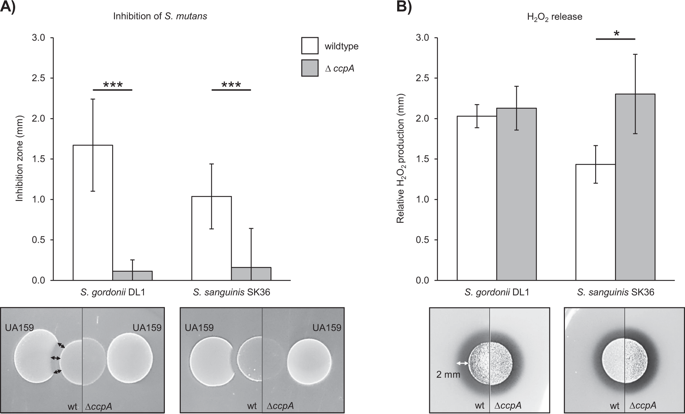Our official English website, www.x-mol.net, welcomes your
feedback! (Note: you will need to create a separate account there.)
Pyruvate secretion by oral streptococci modulates hydrogen peroxide dependent antagonism.
The ISME Journal ( IF 10.8 ) Pub Date : 2020-01-27 , DOI: 10.1038/s41396-020-0592-8 Sylvio Redanz 1 , Puthayalai Treerat 1 , Rong Mu 1 , Ulrike Redanz 1 , Zhengzhong Zou 1 , Dipankar Koley 2 , Justin Merritt 1, 3 , Jens Kreth 1, 3
The ISME Journal ( IF 10.8 ) Pub Date : 2020-01-27 , DOI: 10.1038/s41396-020-0592-8 Sylvio Redanz 1 , Puthayalai Treerat 1 , Rong Mu 1 , Ulrike Redanz 1 , Zhengzhong Zou 1 , Dipankar Koley 2 , Justin Merritt 1, 3 , Jens Kreth 1, 3
Affiliation

|
Many commensal oral streptococci generate H2O2 via pyruvate oxidase (SpxB) to inhibit the growth of competing bacteria like Streptococcus mutans, a major cariogenic species. In Streptococcus sanguinis SK36 (SK36) and Streptococcus gordonii DL1 (DL1), spxB expression and H2O2 release are subject to carbon catabolite repression by the catabolite control protein A (CcpA). Surprisingly, ccpA deletion mutants of SK36 and DL1 fail to inhibit S. mutans despite their production of otherwise inhibitory levels of H2O2. Using H2O2-deficient spxB deletion mutants of SK36 and DL1, it was subsequently discovered that both strains confer protection in trans to other bacteria when H2O2 is added exogenously. This protective effect depends on the direct detoxification of H2O2 by the release of pyruvate. The pyruvate dependent protective effect is also present in other spxB-encoding streptococci, such as the pneumococcus, but is missing from spxB-negative species like S. mutans. Targeted and transposon-based mutagenesis revealed Nox (putative H2O-forming NADH dehydrogenase) as an essential component required for pyruvate release and oxidative protection, while other genes such as sodA and dps play minor roles. Furthermore, pyruvate secretion is only detectable in aerobic growth conditions at biofilm-like cell densities and is responsive to CcpA-dependent catabolite control. This ability of spxB-encoding streptococci reveals a new facet of the competitive interactions between oral commensals and pathobionts and provides a mechanistic basis for the variable levels of inhibitory potential observed among H2O2-producing strains of commensal oral streptococci.
中文翻译:

口腔链球菌的丙酮酸分泌调节过氧化氢依赖性拮抗作用。
许多共生的口腔链球菌通过丙酮酸氧化酶 (SpxB) 产生 H2O2,以抑制竞争性细菌的生长,例如变形链球菌(一种主要的致龋菌种)。在血统链球菌 SK36 (SK36) 和戈登链球菌 DL1 (DL1) 中,spxB 表达和 H2O2 释放受到分解代谢物控制蛋白 A (CcpA) 的碳分解代谢物抑制。令人惊讶的是,SK36 和 DL1 的 ccpA 缺失突变体无法抑制变形链球菌,尽管它们会产生其他抑制水平的 H2O2。使用 SK36 和 DL1 的 H2O2 缺陷型 spxB 缺失突变体,随后发现当外源添加 H2O2 时,这两种菌株都对其他细菌提供反式保护。这种保护作用取决于通过释放丙酮酸对 H2O2 的直接解毒作用。丙酮酸依赖性保护作用也存在于其他 spxB 编码链球菌中,例如肺炎球菌,但在 spxB 阴性物种(例如变形链球菌)中缺失。靶向和基于转座子的诱变显示 Nox(假定的 H2O 形成 NADH 脱氢酶)是丙酮酸释放和氧化保护所需的必需成分,而其他基因如 sodA 和 dps 起次要作用。此外,丙酮酸分泌仅在生物膜样细胞密度的有氧生长条件下可检测到,并且对 CcpA 依赖性分解代谢物控制有反应。
更新日期:2020-01-29
中文翻译:

口腔链球菌的丙酮酸分泌调节过氧化氢依赖性拮抗作用。
许多共生的口腔链球菌通过丙酮酸氧化酶 (SpxB) 产生 H2O2,以抑制竞争性细菌的生长,例如变形链球菌(一种主要的致龋菌种)。在血统链球菌 SK36 (SK36) 和戈登链球菌 DL1 (DL1) 中,spxB 表达和 H2O2 释放受到分解代谢物控制蛋白 A (CcpA) 的碳分解代谢物抑制。令人惊讶的是,SK36 和 DL1 的 ccpA 缺失突变体无法抑制变形链球菌,尽管它们会产生其他抑制水平的 H2O2。使用 SK36 和 DL1 的 H2O2 缺陷型 spxB 缺失突变体,随后发现当外源添加 H2O2 时,这两种菌株都对其他细菌提供反式保护。这种保护作用取决于通过释放丙酮酸对 H2O2 的直接解毒作用。丙酮酸依赖性保护作用也存在于其他 spxB 编码链球菌中,例如肺炎球菌,但在 spxB 阴性物种(例如变形链球菌)中缺失。靶向和基于转座子的诱变显示 Nox(假定的 H2O 形成 NADH 脱氢酶)是丙酮酸释放和氧化保护所需的必需成分,而其他基因如 sodA 和 dps 起次要作用。此外,丙酮酸分泌仅在生物膜样细胞密度的有氧生长条件下可检测到,并且对 CcpA 依赖性分解代谢物控制有反应。











































 京公网安备 11010802027423号
京公网安备 11010802027423号